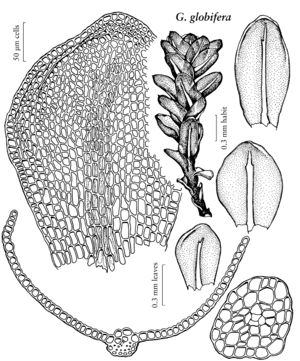familyPottiaceae
subfamilyPottiaceae subfam. Pottioideae
genusGlobulinella
speciesGlobulinella globifera
Globulinella globifera
J. Wash. Acad. Sci. 36: 221. 1946,.
Basionym: Seligeria globifera Hampe Bot. Zeitung (Berlin) 28: 49. 1870
Synonyms: Globulina globifera (Hampe) Brotherus
Revision as of 07:10, 30 July 2020 by imported>Volume Importer
Leaves somewhat crowded above, 0.5–1.5 × 0.3–0.8 mm; distal adaxial cells enlarged and bulging above; costa with 2–4 guide cells. Seta twisted clockwise, 6–8 mm. Capsule 0.6–1.0 mm; operculum conic-rostrate, inclined, 0.5–0.8 mm; peristome teeth 16, cleft and irregular, erect from very short basal membrane. Calyptra to 1 mm. Spores light-brown.
Phenology: Capsules uncommon, maturing fall (Sep–Dec).
Habitat: Calcareous rock, mostly in crevices or rock faces, arid grassland or woodland situations, in pure colonies or gregarious with Crossidium, Aloina, or Barbula
Elevation: moderate elevations
Distribution

Tex., Mexico, Central America
Discussion
Globulinella globifera occurs at isolated sites along the Texas-Mexico border but should be expected on calcareous rock in other parts of the Southwest.
Selected References
None.
Lower Taxa
None.
... more about "Globulinella globifera"
differentiated +
thickened +
revoluble +
deciduous +
developed +
differentiated +
usually slightly wider +
trabeculate +
absent +
usually ovate;oblong +
obovoid +
papillose +
cucullate +
small +
stegocarpous +
specialized +
bulging +
flat to bulging +
thickened +
brownish +
developed +
absent +
spurred +
single +
quadrate +
enlarged +
2-stratose +
stacked +
9mm;16mm +
spiculose +
filiform +
larger +
thickened +
differentiated +
multicellular +
absent +
rare +
asexual +
Calcareous rock, mostly in crevices or rock faces, arid grassland or woodland situations, in pure colonies or gregarious with Crossidium, Aloina, or Barbula +
absent +
absent +
Present +
sheathing +
differentiated +
thickened +
contorted +
appressed +
spreading +
concave;keeled;channeled;ovoid;lanceolate or lingulate +
ligulate +
crowded +
fragile +
bordered +
involute +
specialized +
not differentiated +
thickened +
absent +
inclined +
conic-rostrate +
photosynthetic +
absent +
sheathing +
long-oval +
usually larger +
twisted +
irregular +
absent +
J. Wash. Acad. Sci. +
straight +
oblique +
single +
absent +
twisted +
redbrown +
elongate +
light-brown +
round +
larger +
appressed +
erect +
simple +
sheathing +
forked +
Globulinella globifera +
Globulinella +
species +
oblong +
dark green;golden brown or reddish-brown +
small +
